Maxwell Emitters not working...Please Help
-
Thanks Jason.
You were right. Needed to only make emitter in one place, and turn environment to none, and lower EV.
Legend!
-
mmmm one more question if I may....
I have lighting working now and have a lot to learn about it. When I click the Maxwell Fire preview within sketchup I can see my lighting on the scene which is great. When I render the scene via the Maxwell Render button, and the render finishes, I get no lights.
FURTHER to this (but probably the same issue) I actually have a small network render farm running now to help speed things up and want to be able to use the Maxwell Network Render button from within SketchUp (blue one) and let the network do the hard work, but I suffer the same issue as above. Renders dark with no lighting showing.
I am wondering if I MUST go through Maxwell Render or Studio first to get it right, or should I be able to do the rendering correctly directly from the SketchUp Maxwell Plugin?
Again, thanks in advance!
-
Hrmmm....further info on my issue.
I export to Studio. Enable "Fire" preview, and scene looks great. Then hit "render viewport" and scene is dark (just like when I render from google sketchup). So from what I can tell, Fire is a separate process of sorts to Studio/Render/Network, etc.
So I need to figure out how to get lighting to show up when I hit render viewport and I think I will have this one sorted.
-
It should work. May I ask when hitting the Render Button ( not fire ) is the light shown up in the preview window on the left bottom corner?
-
There are a few possible causes to this -- but first let me make sure you are using the latest plugin and Maxwell (2.6.10)... this update solves some problems with emitters in SketchUp.
Here's the basic checklist of potential emitter issues and solutions:
-
Emitter materials emit in the direction of the surface normals -- what this means is you want to apply the emitter material to the front face of your polys... this is easy to check by setting your faces to monochromatic. As an aside, I only use the front face when modeling and texturing and it is a good practice to get into.
-
Check your emitter geometry (using the Entity Info dialog) to make sure there are no other materials applied to the backside of the emitter polygons -- if there is, remove it (by setting to material default using Entity Info).
-
Make sure there is no other geometry residing in the exact same place as the emitter geometry -- for instance if you create a ceiling and then simply place a few rectangles on it both geometries are in the exact same location. This causes issues with all materials not just emitters.
-
Set the group/component to separate by material (via the context click Maxwell menu).
-
If things still aren't working, disable "use instances" -- in the past emitter materials could not be inside instances... this should be fixed in the newest versions but there may be an issue still.
-
If all of that does not work, then simply explode the geometry... which should definitely clear up the issue.
-
if all of that does not work, change the names of your Emitter materials and your SketchUp file... if this final thing is the culprit then you will need to empty the temp directory and/or the output directory as they contain old materials/files with the same names and Maxwell is getting confused as to which you want to use(this should not happen, but is a remote possibility).
Best,
Jason. -
-
Sorry for jumping onto this post but I'm about to lose the will to live!!! Jason, I've see your name pop up a few times within this forum and I NEED YOUR HELP!!! I've been trying to follow the above advice you gave re: applying IES emitter as a MXM file (I'm using the free Maxwell Render Plugin) and it just ain't happening for me. Can you please take me through each step (i.e. an idiot's guide) because there is something I'm missing. On a side note initally when I tried to use the IES MXM files they weren't listed as MXM but IES. I had to copy a bunch of IES MXM files from a different post you had previously contributed to. Why were these IES files not already listed as MXM on my PC??
I've attached a pic of the render I'm currently working on, where I'd like to include IES emitters. I appreciate that the resolution on the free Plugin is very limited but when I save the final render as PNG/JPEG it loses clarity from what it looked like in Maxwell Render (even at the lower res). Any ideas how I can prevent this?
You'll make my day, if you reply to this!!!

Neets
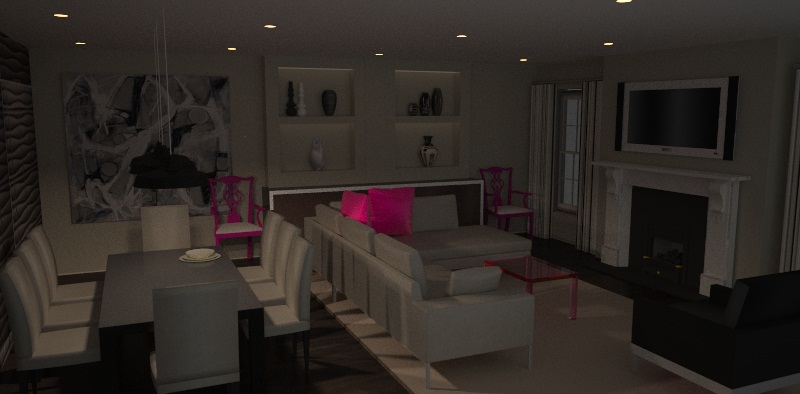
-
Well first off there are two separate components relevant to MXM-based IES materials -- which is to say there is a Maxwell material (called an MXM) and also an IES data file, which is used by the Maxwell material to generate the light pattern.
That said, I would not bother with MXM-based IES material these days since the newer versions of the Maxwell plugin all allow for an "embeded-type" IES emitter material. To do this you should select the Materials tab (of the Maxwell Scene Manager dialog) choose the SketchUp material you wish to make an IES emitter (from the dropdown) and choose a Character>Type of "IES File".
From there you can link to any IES data file you want to use, as well as customize the intensity and Kelvin temperature.
The only other important thing to know about IES files in Maxwell is that they need to be applied to small Spheres -- to direct the light you simply move and/or rotate the sphere geometry.
I have always seen a subtle loss of detail when saving to jpeg from Maxwell because the internal Maxwell render is always a high bit-depth image, but a jpeg tends to be 8-bit so it does not support some of the refined details. My solution has always been to output to high-bit depth for post processing, after which I will reduce to 8-bit... obviously this workflow is not possible with the stand-alone plugin.
Best,
Jason. -
Jason, thank you for taking the time to reply to my query
 Unfortunately I'm no further on. And now I'm about to throw my laptop out of my window! I have assigned a material to a small sphere - the sphere is located just in front of the canvas in the room. I have selected 'emitter ies' from the drop-down list at 'Scene', under the 'Character' properties I have chosen 'IES file' beside 'Type' and I've attached the IES File. I also have the intensity setting at 9 which is very high. And nada. Zilch. Long drawn out sigh I've attached a pic of what I'm trying to achieve and a pic of what I've just rendered using the above settings. Can you shed a bit of 'light'??!! I apologise for the terrible pun!! Thanks for the explanation re: losing clarity in JPEG format. You kinda lost me with all the 'bit' talk but seeing as there's not much I can do with the Standalone version, I'll have to make do. Although I wa considering purchasing the Plugin for Sketchup to have a better resolution - I'm assuming this will still make a difference?
Unfortunately I'm no further on. And now I'm about to throw my laptop out of my window! I have assigned a material to a small sphere - the sphere is located just in front of the canvas in the room. I have selected 'emitter ies' from the drop-down list at 'Scene', under the 'Character' properties I have chosen 'IES file' beside 'Type' and I've attached the IES File. I also have the intensity setting at 9 which is very high. And nada. Zilch. Long drawn out sigh I've attached a pic of what I'm trying to achieve and a pic of what I've just rendered using the above settings. Can you shed a bit of 'light'??!! I apologise for the terrible pun!! Thanks for the explanation re: losing clarity in JPEG format. You kinda lost me with all the 'bit' talk but seeing as there's not much I can do with the Standalone version, I'll have to make do. Although I wa considering purchasing the Plugin for Sketchup to have a better resolution - I'm assuming this will still make a difference?Thanks
Anita

![iesroom[1].jpg](/uploads/imported_attachments/BSQX_iesroom1.jpg)
-
Here's a sample scene with 3 IES lights in a blank room so you can see the correct setup.
Best,
Jason.
-
Jason, thank you very much - I've rendered your scene and it looks great. I checked your set up in the Scene Manager and I can see where I've been going wrong - in your 'Materials' section at the very top where you select a material, you have the name of the IES file in addition to selecting it at the bottom where it says 'IES file'. How did you get the name of the IES file in the materials section at the top?
Anita
-
When I created the SketchUp material I named it the same name as the IES file (to keep things straight for myself).
It's worth checking my camera settings against yours and also trying to modify my simple scene with your desired IES files to make sure everything is working right before you try to go back to your current scene... or at least I always find it helpful to try to work with new things in a simplistic setting first.
Best,
Jason. -
Jason, I have the absolute delight and pleasure in telling you that it FINALLY worked!!! Thank goodness!! I took your advice and set up my own simple box in a new Skp file and it worked. But could I get it to work in my own scene? Of course not! So I ended up turning off all the emitters and still it wouldn't work. Then in a last ditch attempt I reversed faces of the spheres and TA DA!!! I've attached a pic just to prove it - although the image is quite noisy and I seem to have a glow of some description on the sofa near the cushions AND it would appear that I have a gap in one of the recessed wall units that some light from one of the IES emitters is letting through!!! Double sigh. I started getting to grips with emitters on Friday evening and I've learned loads this weekend - I'm over the moon!! Rendering technology never ceases to amaze and astound me
 It's a pity my friends don't feel the same - their eyes glaze over when I talk about it or show them the fruits of my labour. So how come you're such a whizz at Sketchup/Maxwell Render?? I'm assuming your day job involves all this CAD stuff?!
It's a pity my friends don't feel the same - their eyes glaze over when I talk about it or show them the fruits of my labour. So how come you're such a whizz at Sketchup/Maxwell Render?? I'm assuming your day job involves all this CAD stuff?!Thanks again for your assistance

Anita
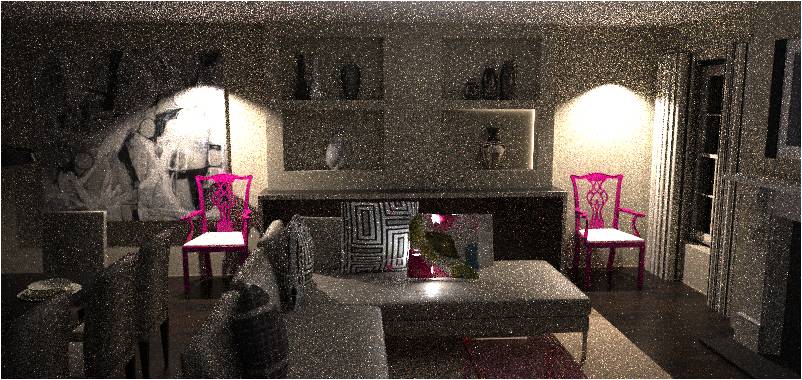
-
I'm glad you got it sorted

I also talk about this stuff to my friends, and I get the glazed look too... but I don't let it get to me.
I'm a bit of an odd case... I use 3D primarily as a tool for generating reference images for my artwork -- similar to the way that I take reference photos with a camera. I tend to work in a realistic style and light is very important to me... so Maxwell is a natural fit for what I do. The thing I like most about working in 3D is the fact that I can setup scenes that would be prohibitively expensive and/or impossible to do with a camera in the real world.
Best,
Jason. -
Hi Jason,
You've no idea how glad I am that I've finally cracked that IES emitter thing (with your help of course). But I'm finding that the more light sources I use, or if they are slightly stronger the worse noise/speckles I get in the image. I've seen loads of examples online of picture perfect renderings - how is this possible??!! I even tried to use Photoshop to reduce the noise but it blurs slightly - so you lose clarity yet again. Will the paid Plugin make any difference to the outcome? I've attached a few images for reference.The EV setting is quite low and I'm using Image Based Environment Settings.
I've actually spent ALL weekend practising my rendering...I think I need to get out more!
Sounds like your friends are very similar to mine - they just don't get it!!
Anita
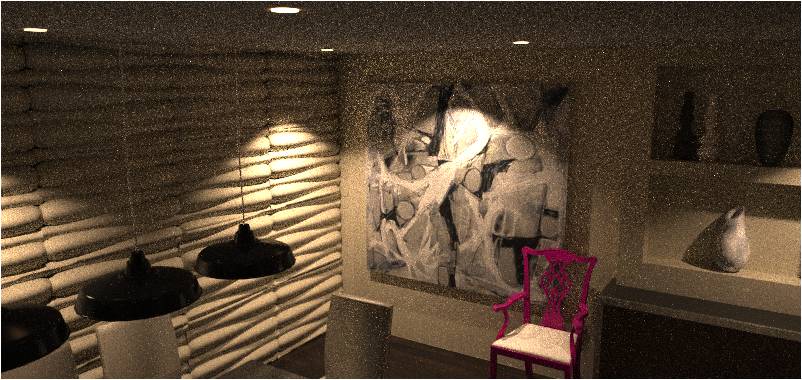
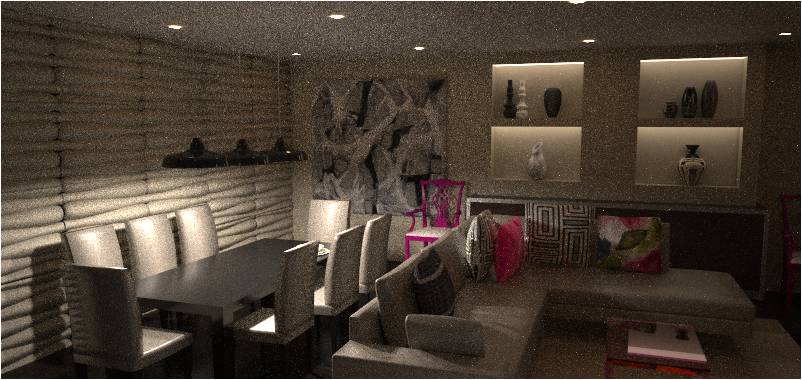
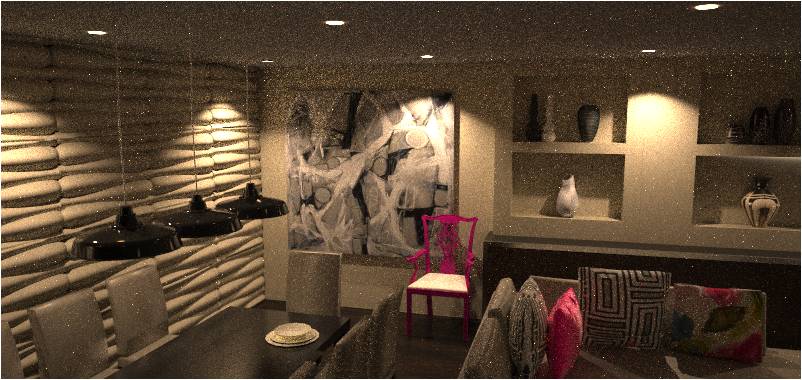
-
The paid plugin contains the real "production" Maxwell Render engine -- whereas the free version contains only the FIRE "real-time" preview engine. IMO the FIRE engine is really only suitable for product rendering shots or outdoor scenes since it is meant for quick calculation of simple lighting. Whereas the "production" engine is going to give much better results for complex lighting (like you would typically find with indoor scenes).
That said, at this point you may find it is a better value for you to go this path instead of the "pro/paid" version of the stand-alone plugin): http://www.maxwellrender.com/education/learning_edition
Best,
Jason. -
Hey!
I'm not 100% sure what the time difference is but I'm guessing you either went to bed really late or were up really early??! Thanks for explaining that to me - I didn't realise that FIRE was of a lower standard - but it makes sense.
I didn't realise that you could get a student/non-commercial version, so I downloaded the Demo (which I found accidentally today). And oh my!! The result was absolutely fantastic (IMHO). This render took 4 HOURS!! I was able to get dressed, washed, put my make-up on, clean the dishes, go grocery shopping and eat dinner in the timeframe that it took to render!!! lol I'm about to embark on an Interior Design Degree (I'm currently finishing a Diploma) and need to make a decision about which rendering software application I'm going to use. I've already ruled out 3DS Max - the learning curve is just too steep. Although I've self-taught AutoCAD but I think I'll just use it for technical drawing. I'm very content to stick with Sketchup (I'm not sure if it's worth opting for the Pro version) and use either Maxwell Render or VRAY. Are rendering times usually this long? In other words, would VRAY take as long? I like the fact that Maxwell Render is very realistic and would be content to wait longer for a decent scene - my only worry is that I mightn't be completely happy with specific details once it has been completed. I know there's a Preview screen but it's quite small. I suppose I could FIRE it up first to get an idea and then proceed to the full Render.
I've attached a pic of my render in the full suite today. I stopped the render at 16 SL - I'm assuming I probably should have let it continue for a while longer for the purposes of clarity??!! I hope you like it

Anita
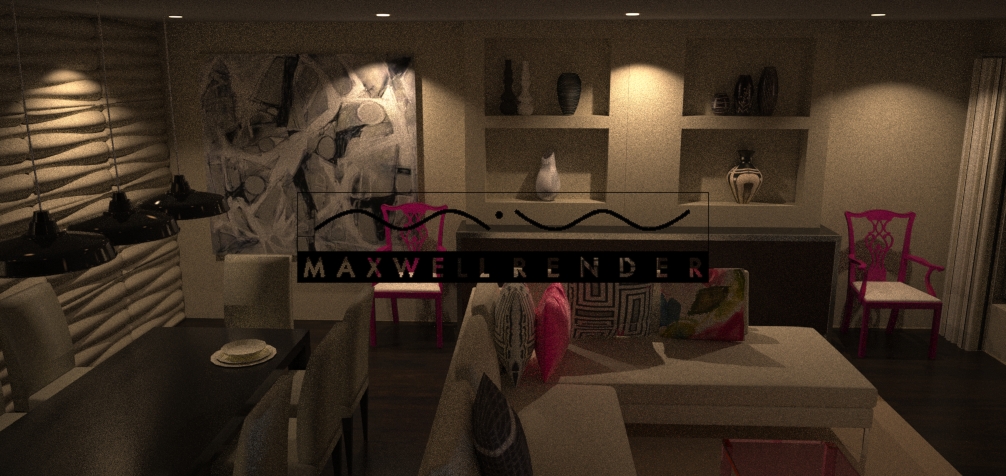
-
Maxwell is much maligned for its long render times -- and certainly compared to a biased renderer (like Vray) it will take much longer. This is particularly true of interior shots, which would likely be your primary use for the software.
Typically I leave my final renders cooking overnight, so they usually get about 12-16 hours to get to what I would call done (typically SL 20) for a good sized render.
From my POV it really all comes down to what you need the software for -- it you are going to be doing just a few high quality renders a week then Maxwell is an excellent choice. If on the other hand you expect to be doing several per day then you should probably look at a biased solution. That's not to say there aren't studios using Maxwell for animations, where you would need alot of frames per day... they just have the computing power to throw at the problem (the full version of the render suite allows you to network computers together to speed up the process). With Maxwell the end result is the only real way to speed things up (at a certain point) is to use a stronger computer (or many of them together).
For the record I do own a few biased render engines, and while they are cool to play with, what I need for my work is what Maxwell gives... and I don't mind waiting for it.
SketchUp Pro has a few advantages with Maxwell but probably not enough to justify the expense on that alone... currently the best argument for SketchUp Pro is Advanced Camera, Layout and Dynamic Components.
Best,
Jason. -
Wow, overnight??!! That doesn't really surprise me. Hmmmm decisions, decisions!! I'm slightly relunctant to try and learn a new render engine when I've become used to Maxwell Render. I'm completely self-taught and the thought of having to start from scratch is a tedious thought. But I have heard a lot of good things about VRAY. And I like the fact that it's quicker too. Although, like you I've seen others who own different applications and use them for different reasons. Question: I'm currently 'cooking' at the minute (I'm making the most of this Demo while I still have it) and obe of my scenes is currently at SL 12 (no emitters) and there's a box to the left of where it stipulates the SL number that shows 1% Render - this 1% has only just appeared after nearly 2 hrs of rendering - what does this 1% refer to??
I'm loving the Mulit-Light function - I'm assuming this means I can add scenes with varying degrees of lighting and it will animate it?? I might try that tomorrow. Can you animate without using emitters? For example, the gradual movement of sunlight/shadows in a scene?
I found the Layout options in the Pro version to be very handy (I downloaded a trial), particularly for technical drawing. But I do think AutoCAD is the better application for ensuring precision.
I'd love to see some of your renders - if you don't mind? But if you'd rather not, that's ok

Anita
-
[off:1gk2t6ws]
@unknownuser said:I'm slightly relunctant to try and learn a new render engine when I've become used to Maxwell Render.
Anita
Anita, please forgive me, but I felt it might be helpful to interject. If you are embarking on a design career--get used to moving into new software, because it will keep changing and so will your needs. Also I've seen it noted, the hardest CAD to learn is the second software. But there are, of course, methods that carry over.
IMHO, what you use will depend more on your needs and your resources (time and money), and you'll just have to do it. I'm sure you don't mean to be cutting yourself off from potentially useful tools, because you already have one. Take it from someone who started his so-called career with a pencil and T-square. (Or not
 ) Regards, Peter[/off:1gk2t6ws]
) Regards, Peter[/off:1gk2t6ws] -
Hi Peter

Oops, that's me told!! lol I appreciate and acknowledge your point about not being close-minded when it comes to learning new things. And I really do enjoy stretching myself, I think it's the self-taught method that I find tedious more than anything to be honest. My teaching method involves trial...error...tantrums...a few glasses of wine (maybe not the best of ideas but it can be handy when one is required to be creative!!!)...and then a few more tantrums!!! hehe I have to say though my biggest achievement has been getting to grips with AutoCAD - I refused to let it beat me.
When you say 'second software' which one are you referring to exactly? VRAY? I'm guessing with your 'T-square' comment that you are in Design/Architecture? I'm interested to learn what CAD software you use?
Anita
Advertisement







